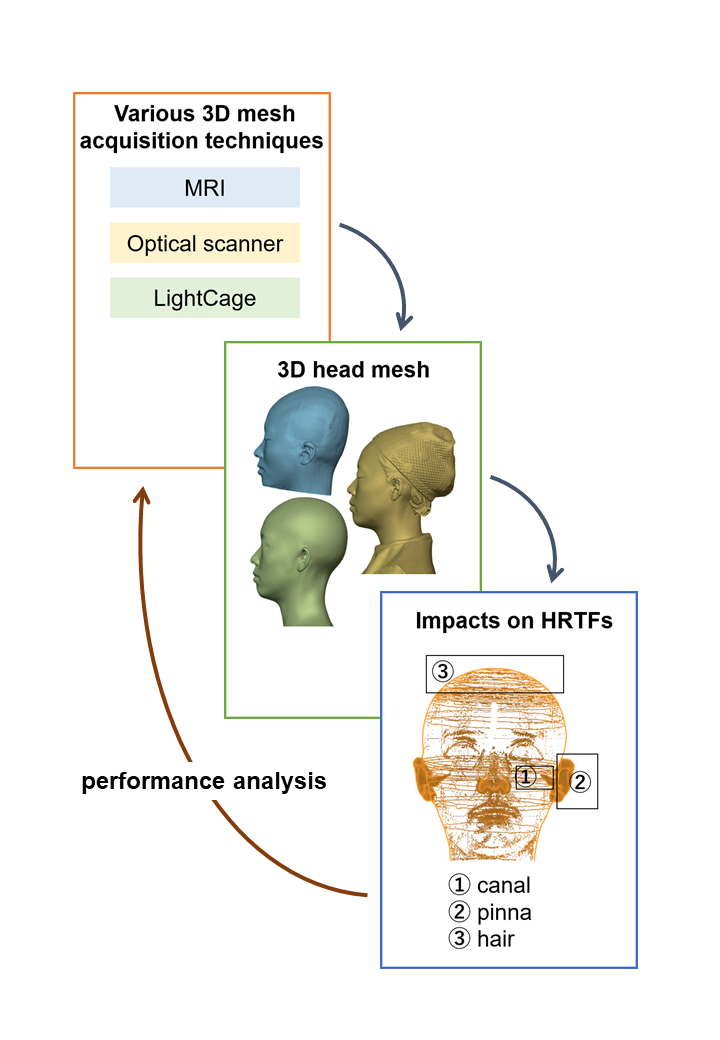Home / Publications / E-library page
You are currently logged in as an
Institutional Subscriber.
If you would like to logout,
please click on the button below.
Home / Publications / E-library page
Only AES members and Institutional Journal Subscribers can download
The head mesh is a fundamental component in simulating head-related transfer functions (HRTFs). The techniques utilized for acquiring and preprocessing 3D meshes prior to calculation directly influence HRTF results. This study aims to compare the meshes obtained through different methods and analyze the impact of mesh differences on HRTFs. Three mesh capture methods based on different technical principles were employed to obtain the meshes of the human head: magnetic resonance imaging, optical scanner, and LightCage. A comparative analysis revealed that the lateral pinna parameters of the magnetic resonance imaging mesh tend to be larger than those from other methods owing to the lack of ear shape preservation, leading to significant variations in HRTF. The impact of differences in the canal and hair areas of the meshes on HRTFs was also evaluated, revealing that the canal had minimal influence on directional transfer functions of HRTFs. Moreover, bulging caused by hair did not affect localization performance. Based on these results, the study analyzed the advantages and limitations of various methods and their corresponding principles. This research serves as a reference for selecting head mesh acquisition methods and mesh preprocessing for HRTF simulations.
Author (s): Sun, Chang; Okubo, Kan
Affiliation:
Graduate School of Systems Design, Tokyo Metropolitan University, Tokyo, Japan; Graduate School of Systems Design, Tokyo Metropolitan University, Tokyo, Japan
(See document for exact affiliation information.)
Publication Date:
2025-04-07
Import into BibTeX
Permalink: https://aes2.org/publications/elibrary-page/?id=22812
(935KB)
Click to purchase paper as a non-member or login as an AES member. If your company or school subscribes to the E-Library then switch to the institutional version. If you are not an AES member Join the AES. If you need to check your member status, login to the Member Portal.

Sun, Chang; Okubo, Kan; 2025; Analysis of Various 3D Acquisition Techniques and Mesh Differences for Head-related Transfer Functions Calculation [PDF]; Graduate School of Systems Design, Tokyo Metropolitan University, Tokyo, Japan; Graduate School of Systems Design, Tokyo Metropolitan University, Tokyo, Japan; Paper ; Available from: https://aes2.org/publications/elibrary-page/?id=22812
Sun, Chang; Okubo, Kan; Analysis of Various 3D Acquisition Techniques and Mesh Differences for Head-related Transfer Functions Calculation [PDF]; Graduate School of Systems Design, Tokyo Metropolitan University, Tokyo, Japan; Graduate School of Systems Design, Tokyo Metropolitan University, Tokyo, Japan; Paper ; 2025 Available: https://aes2.org/publications/elibrary-page/?id=22812
@article{sun2025analysis,
author={sun chang and okubo kan},
journal={journal of the audio engineering society},
title={analysis of various 3d acquisition techniques and mesh differences for head-related transfer functions calculation},
year={2025},
volume={73},
issue={4},
pages={193-206},
month={october},}